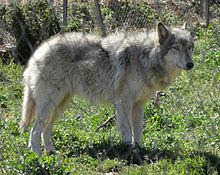Ceiridwen’s experience and records of living with and raising a wolf-dog mix offer insight into the difference between a tame animal and a domesticated one. Based on this reading I would argue that cats as a whole cannot be called domesticated, though many individuals act domesticated.
Ceiridwen’s wolfdog, Inyo, is tame. She is relatively calm around people and doesn’t attack them, even when provoked. Inyo was able to be trained and kept as a pet, but still retained behaviors attributed to wolves. Hiding her food for times of hunger, and howling rather than barking, Inyo was by no means completely domesticated. There are a variety of breeds of wolf dog, some of which have surprising features.
Inyo’s independence and lack of blind obedience lend credence to one of the breeder’s statements that, “Dogs are retarded wolves.” I was reminded by this of how cats act in comparison to dogs. While dogs are blindly loving and relatively obedient, barring abuse, cats are more independent, aloof, and far less trainable. Cats act more like the wolfdog hybrids, tolerating and even being fond of people, but retaining their own agendas. As a whole cats would be better described as a species that adapted itself to a niche opened up by people, rather than as domesticated.
One suggestion that arose in class as to how wolves had been domesticated was that the wolves adapted themselves to live around humans. This idea was supported in the reading by the idea of genetic tameness preceding full domestication. This would also support the idea that wolves were domesticated in different areas at different times. This would also explain how different researchers determined that dogs had been domesticated in both the Middle East and China. I do find it dubious that dogs were domesticated in China as food animals, as they’d be horribly inefficient from an energy standpoint.
The legal ramifications of wolfdog hybrids was explored well in the reading, as Ceiridwen was forced to lie about her wolfdog’s identity to get it vaccinated. The threat of Inyo being put down has been ever-present, and her identity being something of an open secret will likely become a problem. Most of the laws seem to either outright declare the hybrids illegal, or give them the benefit of the doubt up until they cause any bodily or property harm. While the laws do appear unfair in how they’ve been portrayed, they do exist for a reason. Not all hybrids will be as calm as Inyo, and the breed has the capacity to do major harm to a person if it attacked in full force. Personally I’d be inclined to agree with the benefit-of-the-doubt laws, though with more wiggle room for exceptions and slip-ups.
(images are pulled from wikipedia)



